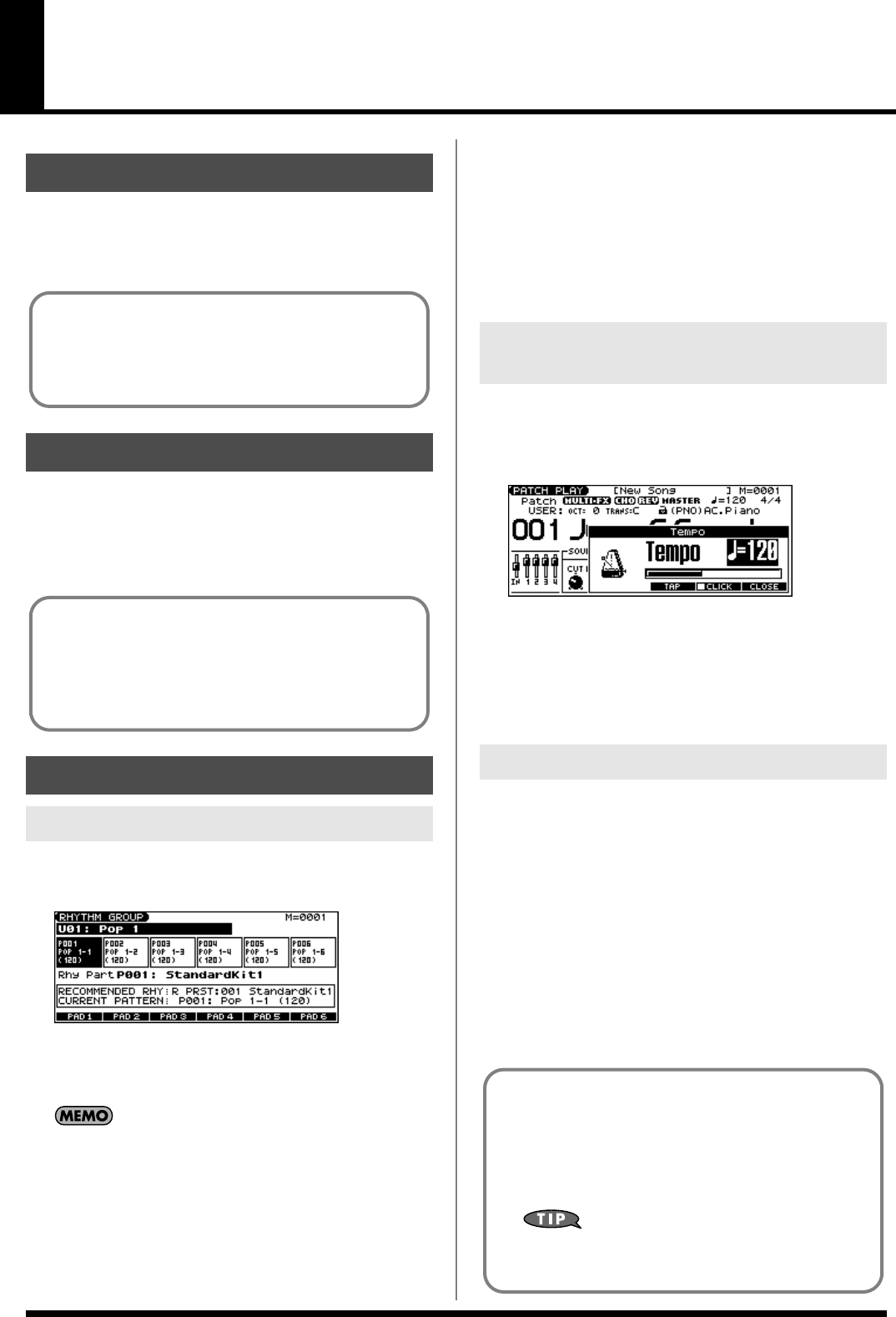
79
Playing Rhythms
The JUNO-G contains 256 preset rhythm patterns. You can play a
variety of rhythm patterns simply by pressing the function buttons
([F1]–[F6]). In addition to using these built-in rhythm patterns, you
can also create your own.
A “group” consists of settings for each of the six buttons, specifying
the pattern that each function button will play. The rhythm set used
by that group is also stored as part of the settings.
* You are free to change how rhythm pattern numbers and rhythm
sounds are assigned.
1.
Press [RHYTHM PATTERN].
The RHYTHM GROUP screen appears.
2.
Play a function button ([F1 (PAD 1)]–[F6 (PAD 6)]).
According to the button you pressed, the assigned rhythm pattern
will begin playing. The currently playing button will blink.
The pattern or rhythm tone that is sounded by each button can
be specified in Rhythm Group Edit (p. 82).
3.
If you press a blinking button, the pattern will stop playing.
4.
Press [EXIT] to close the RHYTHM GROUP screen.
You can also press [EXIT] to close the RHYTHM GROUP screen
while a rhythm pattern is playing. In this case, you can press
[RHYTHM PATTERN] once again to open the RHYTHM
GROUP screen and press the blinking function button to stop
the pattern playback.
* You can also stop the pattern playback by pressing SONG
RECORDER [STOP].
This sets the Rhythm Pattern tempo.
1.
Press SONG RECORDER [TEMPO].
The current tempo value appears in the display.
2.
Use the VALUE dial or [INC] [DEC] to set the tempo value
(5–300), or set the value by tapping [F4 (TAP)] a number of
times with the same rhythm (Tap Tempo).
* If you press [F5 (CLICK)] to add a check mark (
✔
), the click will sound.
3.
When you have made the setting, press [F6 (CLOSE)].
1.
Press [RHYTHM PATTERN].
The RHYTHM GROUP screen appears.
2.
Use the VALUE dial or [INC] [DEC] to select a Rhythm group
number.
This selects the Rhythm group’s basic performance Style.
U01–32:
User
P01–32:
Preset
* When you select the Rhythm group, the most suitable rhythm set is
assigned to the Rhythm part. (In the screen, this is indicated by
“RECOMMENDED RHY PATTERN.”
3.
When you have finished selecting a Rhythm group, press [EXIT].
About Rhythm Patterns
Using Rhythm Groups
Playing Rhythm
Using the Rhythm Function
The 256 rhythm patterns are maintained as independent data;
they are not part of a performance’s data.
This means that any one
rhythm pattern can be shared by various rhythm sets or performances.
In
Performance mode, a number by which a rhythm pattern is
recalled can be stored as one of the performance parameters.
This number cannot be stored in Patch mode.
Rhythm group data is not part of a rhythm set or performance;
the 32 rhythm groups are stored as independent data. This
means that any one rhythm group can be shared by various
patches or performances. In addition to using the built-in
rhythm groups, you can also create your own.
Rhythm Group settings can be saved independently for each
performance. However, they cannot be saved as part of a patch.
Determining the Tempo for Rhythm
Pattern Performances
Select the Rhythm Group
Recording the Rhythm Pattern Playback to
Song Recorder
In the RHYTHM GROUP screen, record the rhythm pattern to
Song Recorder.
In recording standby mode, when you press [PLAY] (or [F6
(START)]) the current rhythm pattern will start playback at the
same time, and you can record the rhythm pattern.
If you want to record the rhythm pattern at the same time
that it starts playback, set the Count In to Off in the
recording standby window.
JUNO-G_e.book 79 ページ 2006年2月13日 月曜日 午後2時44分


















